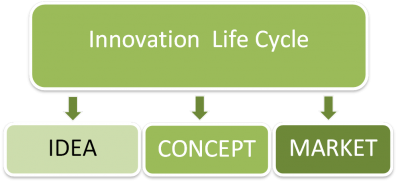Metodi di Innovazione
Il metodo 2inno
"Ottieni il quadro di insieme" - il metodo 2inno è basato su un approccio olistico e pratico:

Fonte: House of Innovation, di A.T. Kearney
L'approccio olistico e pratico del metodo 2inno
Durante la fase di ricerca preliminare ci siamo imbattuti in altri progetti che utilizzano un approccio simile: ad esempio il progetto IMP3rove della CE per il miglioramento della Innovation Management Performance delle PMI Europee. L'approccio è metodologicamente simile a quello utilizzato da 2inno: pratico, modulare, basato sull'autoapprendimento. Uno scopo importante del progetto è stato anche quello di analizzare i bisogni di consulenza sulla gestione dell'innovazione nelle PMI:
“Although a wide range of best practices is already available to SMEs, there is room for improvement, both in terms of conceptual issues and market penetration. […] Indeed, a new standard of self-assessment tools in the area of Innovation Management is being developed based on best practices identified from this analysis. These best practices in Innovation Management consulting and self-assessment tools also pinpoint certain gaps that need to be closed.” (Eva Diedrichs [et al.], European Innovation Management Landscape, Europe INNOVA paper Nr 2).
Questo è il punto di partenza del metodo 2inno:
-
Le PMI hanno bisogno di un approccio molto pratico. Utilizziamo il metodo DUI: "learning by doing, using and interacting mode". Le piccole imprese dovrebbero essere in grado di apprendere alcuni strumenti pratici in poche settimane, in modo da far partire i primi progetti di innovazione.
-
Le PMI hanno bisogno di assistenza: Per iniziare a gestire l'Innovazione è indispensabile una guida: il primo progetto pilota è un ottimo punto di partenza per le PMI che vorranno continuare ad utilizzare strumenti di IM
-
Le PMI hanno bisogno di formazione specifica e mirata: gli workshop di "Innovation Management" saranno customizzati sulla base delle esigenze delle PMI partecipanti e nel rispetto della loro cultura aziendale, al fine di perseguire il motto „DO innovation now!“
Tornando al modello "House of Innovation" di A.T. Kearney appare chiaro come sia dato un focus importante al "ciclo di vita dell'Innovazione", che è il cuore del metodo 2inno. Lavorando con le PMI ci si deve concentrare su processi specifici in maniera molto pratica. I Coach 2inno attraverso un primo workshop analizzano processi e cultura delle PMI. Poi sviluppano un primo audit dell'innovazione. Una volta che il quadro di analisi è completo, l'iprenditore (e/o i suoi collaboratori chiave) implementano il primo processo di innovazione attraverso questi 3 step:

IDEA – La fase di creazione
We have chosen a whole set of tools and techniques for problem identification, collection, evaluation and filtering of ideas. SMEs will get aware of the important fact to follow certain rules when making a STOP or GO decision. As soon as one innovative idea has been chosen, the 2inno Coaches will lead them to the next step:
CONCETTO – Definisci il tuo Progetto
In this phase the Coaches will help the SMEs to clearly define their innovation project with – at least – the following important steps: The project definition needs to be clear and understandable to all people involved; the core steps of the project development must be defined (process including the overall aim as well as the necessary steps and milestones to reach this aim). In this phase a second STOP or GO decision is important in order to analyse if the implementation of the product / service is feasible (time, costs, knowledge needed, etc.).
MARKET – Vendi il tuo prodotto/servizio
"If you have enough information to make a business case, you’re too late.” [Bill Gates]. Following this input the 2inno Coaches will already start in the IDEA phase to prepare the later market introduction (by a needs analysis and/or direct feedback from customers). During the phase of conceptualization a sort of feasibility study (including a cost-benefit analysis) has to be worked out. Main steps of the MARKET phase: products / services have to be tested and validated, the product release has to be planned and the product distribution to be established. At the end of the third phase SMEs will learn how to evaluate their Business Results, which is essential in order to gain knowledge for further innovation projects.
From the concrete process to the “big picture”
The 2inno consortium is aware of the need to have the “big picture” in mind, when implementing Innovation Management in a company. But: there are different ways to do so. The 2inno method starts with the Innovation Life Cycle (IDEA, CONCEPT, MARKET) by implementing a pilot project together with SMEs. While working on this project, all members of staff involved will get more knowledge on Innovation Management.
The 2inno method focusses on a practical approach and does not want to “overload” SMEs with theoretical information on Innovation Management. One of the major problems we identified when working on Innovation with companies led us to the following question: Why is it so difficult for them to get started? The answer we found so far: Owners of small companies do not want (or do not have the time / money) to get theoretical knowledge. They want to sell their products (often not aware that their products / services are no longer innovative). While working together on a concrete pilot project with the 2inno Coaches owners and key staff of SMEs will understand why further processes regarding Innovation Strategy and Innovation Culture are important.
Copyright © 2inno Consortium



 This project has been funded with support from the European Commission. This publication [communication] reflects the views only of the author, and the Commission cannot be held responsible for any use which may be made of the information contained therein.
This project has been funded with support from the European Commission. This publication [communication] reflects the views only of the author, and the Commission cannot be held responsible for any use which may be made of the information contained therein.